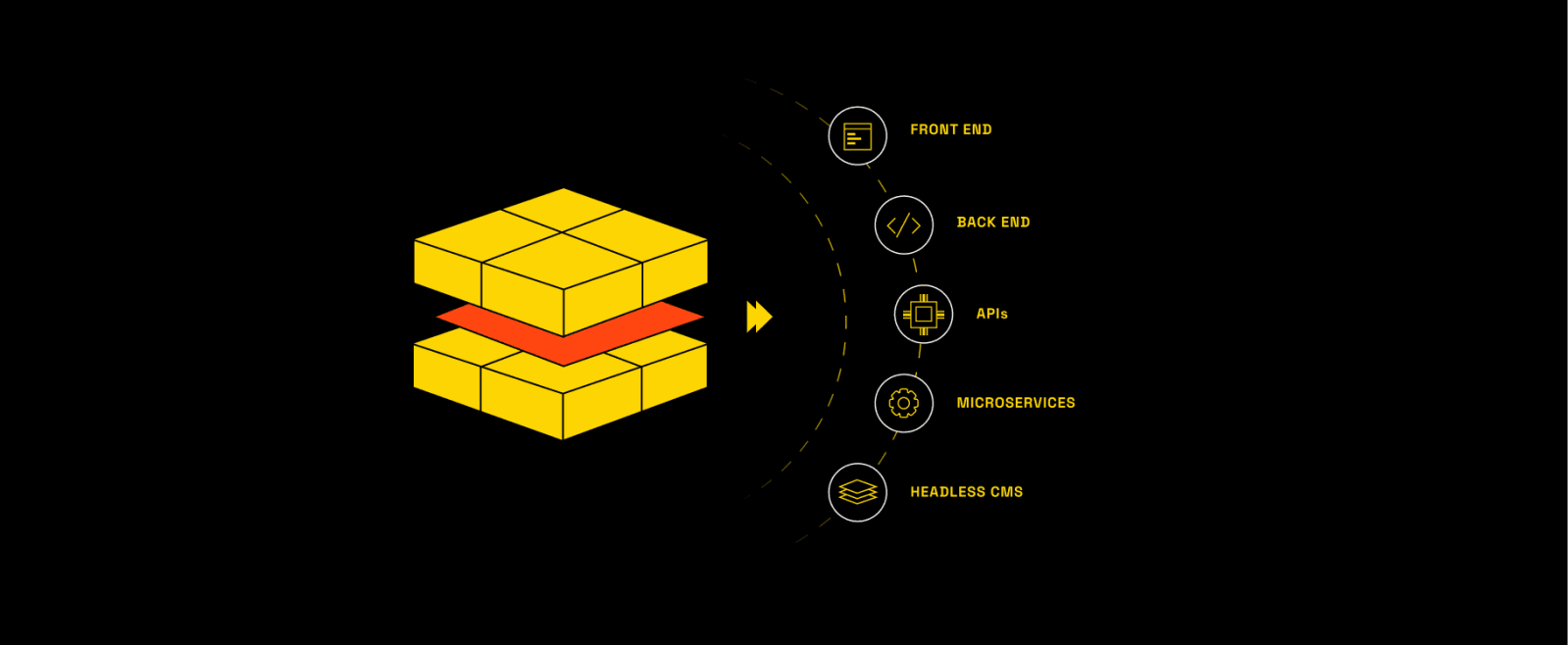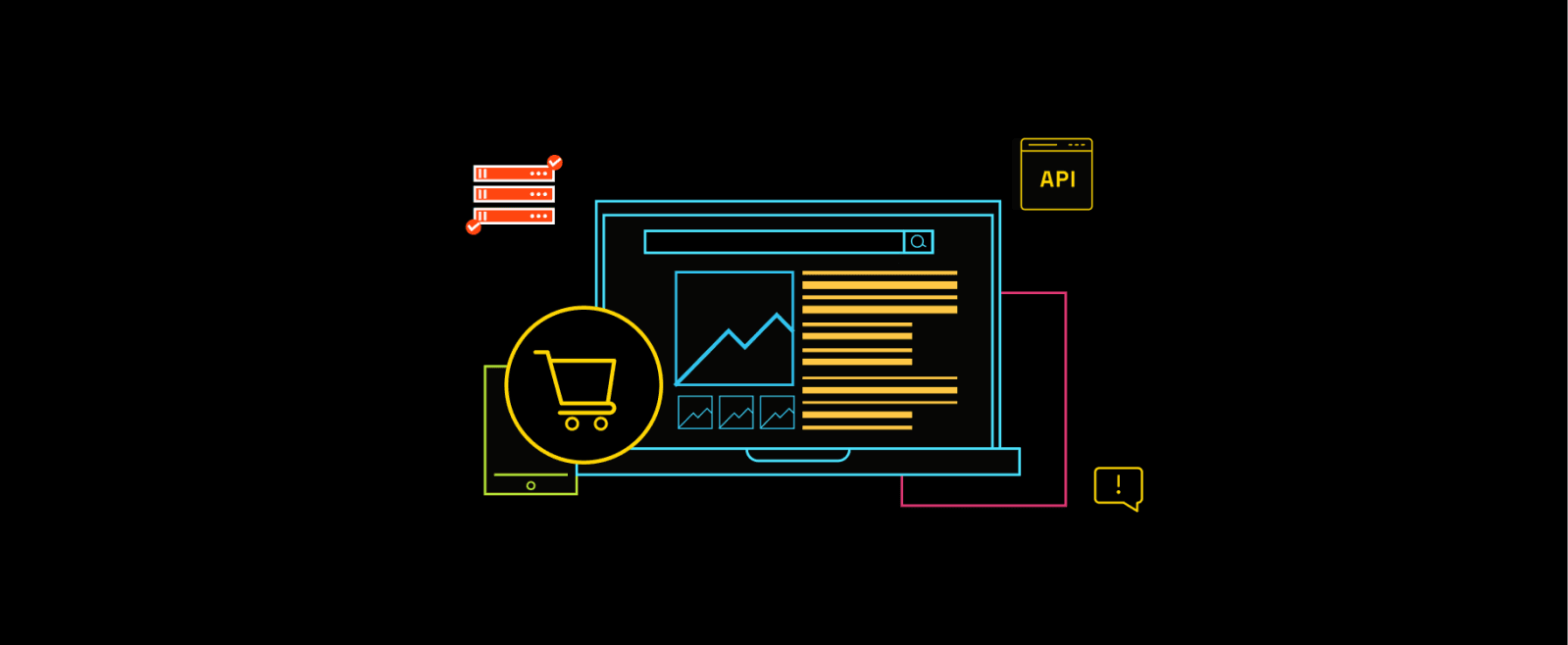Composable Commerce for B2B: The Smarter Way to Build Scalable, Modern eCommerce Platforms
If you're exploring composable commerce, chances are your current B2B setup feels more like a maze than a machine. Maybe it's the rigid platform that takes months to roll out a single change. Or the tangled integrations between your ERP, PIM, CRM, and everything else. Or the fact that your digital roadmap keeps getting blocked by legacy tech and vendor limitations.
Composable commerce offers a way out — not just a new platform, but a new approach. One built on MACH principles: Microservices, API-first, Cloud-native, and Headless architecture. It gives you the flexibility to choose exactly what your business needs, plug in best-of-breed tools, and scale without rebuilding your entire system.
In this guide, we’ll break down what composable commerce really means for B2B, why it's gaining traction with enterprise teams, and how to adopt it in a way that drives results — not just more complexity.
What is Composable Commerce and Why It Matters for B2B
Composable commerce is a shift in how B2B companies build and scale their eCommerce platforms. Instead of relying on a single, rigid system, you assemble your platform using Packaged Business Capabilities (PBCs): specialized, plug-and-play services for things like inventory management, order processing, or content delivery. This composable approach means you’re not locked into one vendor’s roadmap — you choose what fits your business best and evolve on your own terms.
For B2B teams managing complex procurement cycles, integrations, and long sales processes, that level of control can be a game-changer.
To understand why composable commerce is gaining momentum in B2B, it helps to look at what powers it—and what it’s replacing. At the core is a new kind of architecture built for change, known as MACH. And it stands in sharp contrast to the monolithic systems many B2B companies still rely on. Let’s break that down.
Core Principles of Composable Commerce (Powered by MACH Architecture)
At the heart of composable commerce is MACH architecture — a modern approach to building digital platforms based on four core principles: Microservices, API-first, Cloud-native, and Headless. [Explore the MACH architecture in more detail here.] Together, these make your B2B commerce platform modular, scalable, and easier to maintain.
Here’s what that really means: microservices let you run each business function (like pricing, checkout, or catalog) independently. API-first design ensures those functions can talk to each other and your existing systems. Cloud-native makes scaling easier, especially during seasonal spikes or global rollouts. And headless decouples your front end from the backend, giving your team full control over how each experience looks and feels.
Understanding what MACH architecture is, isn’t just technical knowledge — it’s what makes composable commerce work in high-stakes B2B environments.
Why Composable Commerce Is Replacing Monolithic Systems in B2B
Traditional monolithic platforms were built for stability—not speed, flexibility, or change. But in B2B commerce, where you’re managing long sales cycles, custom pricing, and complex integrations, they quickly become bottlenecks. Even small changes—like updating your product catalog or launching a new customer portal—can turn into months-long IT projects. Composable commerce flips that model.
You don’t have to rip everything out. You keep what works—like your ERP or CRM—and plug in modern, purpose-built components around it. That means you can launch new capabilities faster, without waiting on a full replatform. For example, you can add a better search engine or build personalized buyer experiences without touching the rest of your stack. That’s how B2B teams start solving real problems—faster product rollouts, smoother procurement workflows, and better support for multi-tier pricing or custom catalogs.
Key Components of Composable Commerce for B2B Platforms
Composable commerce is made up of real, working parts that solve real operational headaches in B2B. At its core are technologies like MACH architecture and Packaged Business Capabilities (PBCs), along with integration frameworks that make these pieces work together.
This section breaks down the building blocks of a composable system—so you can understand how it all fits together and why it’s a better fit for complex B2B operations than traditional, one-size-fits-all platforms.
Applying MACH Architecture in B2B Composable Commerce
MACH architecture outlines how modern composable B2B commerce platforms are structured. But beyond the acronym, each element plays a role in solving everyday challenges that B2B teams face—like long procurement cycles, rigid workflows, and disconnected tools.
-
Microservices let you break up your platform into smaller, specialized services. For example, you can independently upgrade your quote management system without affecting your catalog or checkout logic—critical when your teams operate on separate release cycles.
-
API-first development means every component—your ERP, CRM, PIM, or OMS—can communicate cleanly. This isn’t just about integration. It’s how manufacturers automate reordering, sync partner-specific inventory, or trigger pricing updates across thousands of SKUs.
-
Cloud-native infrastructure gives you room to scale without reengineering. B2B businesses often deal with unpredictable volume spikes—say, after a trade event or during contract renewals. With cloud-native services, your platform flexes on demand.
-
Headless architecture separates what your buyers see from how your business runs. You can deliver different purchase flows for distributors, retailers, or resellers—without rebuilding your backend logic each time.
Want a deeper look into how MACH powers real-world B2B transformation? [Explore our dedicated guide to MACH architecture in eCommerce]
Understanding Packaged Business Capabilities (PBCs) in B2B Composable Commerce
Packaged Business Capabilities (PBCs) are pre-built, plug-and-play components designed to handle specific business functions—think of them as building blocks tailored to your workflows. In B2B composable commerce, PBCs give you the power to launch and optimize key processes without rebuilding from scratch or relying on generic platform features.
For example:
-
A manufacturing company can use a pricing PBC to manage contract-based pricing tiers across regions and distributors.
-
A distributor might deploy a promotions PBC that automatically adjusts discounts based on buyer type or purchase volume.
-
A service-based B2B brand can implement a billing PBC that integrates directly with CRM and ERP data to shorten the quote-to-cash cycle.
What makes PBCs valuable is that they’re not just modular—they’re business-ready. Instead of writing custom code for every capability, you select only what you need and connect them through APIs to your existing stack. That’s how composable commerce lets B2B brands move faster without compromising on complexity.
How Integration Frameworks and APIs Power Composable Commerce in B2B
In a composable commerce setup, integration frameworks do more than connect systems. They coordinate how those systems work together at scale.
For B2B teams, this isn’t about a one-time connection between your ERP and web store but about managing ongoing, rules-based interactions between dozens of systems: inventory syncs that reflect real-time stock across warehouses, pricing engines that adjust by contract, and workflows that trigger approvals before an order even hits fulfillment.
This is where modern API frameworks and orchestration layers come in. They define how data moves, when it moves, and who governs it—without hardcoding everything from scratch. Instead of writing dozens of one-off scripts, you can use middleware or iPaaS (Integration Platform as a Service) tools to manage integrations more cleanly and with far less maintenance debt.
In short, integration frameworks turn your composable architecture into a reliable, operationally sound system—one that can scale across regions, teams, and business models without falling apart under pressure.
Business Benefits of Composable Commerce for B2B Organizations
1. Built-In Flexibility for Complex B2B Models
Most traditional platforms expect you to adapt your workflows to the system. Composable commerce flips that logic. You choose the components that match your processes — whether it’s multi-tier pricing, account-based catalog rules, or workflows that need procurement manager approval before purchase.
Example: A B2B wholesaler can launch country-specific storefronts that support regional pricing and compliance rules — without rebuilding the core stack each time.
2. Scale Selectively, Not Expensively
B2B businesses often grow unevenly — launching in new markets, expanding catalogs, or onboarding large clients. Composable systems let you scale only the services under pressure. No need to overpay for unused infrastructure or stress-test the entire platform every time one part grows.
Example: A distributor scaling from 500 to 5,000 SKUs can expand search and inventory microservices — without touching the payment or tax engines.
3. Faster Time-to-Value (Not Just Time-to-Market)
Composable commerce accelerates how fast new features or workflows go live — but more importantly, it helps you capture ROI faster. With modular rollouts, you avoid the risk and delays of a “big bang” launch.
Example: A manufacturer adds a self-serve reorder module for repeat buyers — improving conversion in weeks, not quarters.
4. Smarter Spending and Lower TCO
Because you only build (and pay for) what you use, composable commerce reduces wasted costs on bloated, one-size-fits-all platforms. APIs and reusable services also cut down integration and maintenance overhead over time.
Example: A B2B brand replacing just its legacy CMS with a headless solution saves on dev cycles while improving content speed across multiple markets.
5. A Platform That Grows With You
Composable commerce isn’t about switching platforms again in five years. It’s about designing an architecture that evolves with your business — letting you upgrade search, personalization, or checkout as needed, without risking downtime.
Example: A growing industrial supplier swaps in a new promotions engine while preserving all other integrations and workflows.
Each of these benefits tackles core B2B friction points: outdated systems, long decision cycles, regional complexity, and cost-heavy development. The real value of composable commerce is that it gives you control — not just over your tech stack, but your ability to compete, scale, and adapt on your own terms.
Composable Commerce Implementation Challenges in B2B (and How to Solve Them)
Composable commerce promises flexibility—but getting there isn’t always plug-and-play, especially for B2B organizations with years of investment in legacy platforms. Migrating from monolithic systems to a composable setup introduces challenges across integration, operations, and internal adoption.
But these challenges are solvable—with the right planning, prioritization, and partners.
According to Gartner, by 2026, 70% of large organizations will use composability in digital commerce to deliver faster time-to-market and greater business agility.
This section breaks down the three most common roadblocks B2B companies face during implementation—and how to navigate them.
1. Integration with Legacy Systems
For B2B companies, the biggest technical challenge with composable commerce isn’t building from scratch—it’s connecting modern services to legacy systems without disrupting operations. ERP, PIM, and CRM systems often carry years of business rules, dependencies, and workflows that aren’t API-ready or built for modularity.
The real complexity lies in orchestration: making sure composable components (like checkout, promotions, or pricing engines) not only integrate with core systems, but stay in sync as those systems evolve.
To address this:
-
Use centralized API management platforms to enforce communication standards and monitor interactions.
-
Set up integration patterns for critical processes like order-to-cash or inventory sync before writing code.
-
Employ middleware or iPaaS tools to connect legacy systems while minimizing custom engineering effort.
Tip: Don’t treat integration as a one-time task. Treat it as a capability—something you’ll optimize continuously as your architecture evolves.
2. Internal Adoption and Change Resistance
Composable commerce introduces new tooling, workflows, and ways of working—not just for engineering, but for product, marketing, operations, and sales teams too. And if your teams don’t understand the shift, even the best architecture can stall.
The biggest mistake B2B organizations make? Rolling out composable without preparing the people using it.
What works instead:
-
Role-based onboarding: Don’t train everyone on everything. Tailor onboarding for developers, merchandisers, product teams, and execs separately.
-
Cross-functional squads: Pair technical and business users in agile teams focused on delivering one business capability at a time.
-
Clear documentation + async demos: Replace knowledge silos with well-documented flows, and record demos for self-paced learning.
-
Create champions: Identify 2–3 internal team members who can advocate, coach, and bridge the learning curve.
Remember: Composable is as much about team enablement as it is about tech flexibility.
3. Budgeting and Phased Implementation
Composable isn’t all-or-nothing. But that flexibility can also be a trap—if you don’t prioritize the right capabilities first, costs can spiral fast.
Smart B2B businesses start by answering one question:
“What’s the first part of our commerce experience that’s actually limiting growth?”
That becomes your entry point—whether it’s pricing complexity, catalog management, or slow content deployment.
Once you identify it:
-
Build a phased budget tied to business value, not just features.
-
Invest in training up front—especially for internal product owners and systems architects.
-
Consider external implementation partners who’ve done composable before, especially if you need ERP or PIM integration.
And remember: success isn't launching everything fast. It’s launching the right things, in the right order, with the right people.
How to Get Started with Composable Commerce in B2B (The Right Way)
Getting started with composable commerce isn’t about choosing the flashiest stack or racing to go headless. It’s about making deliberate decisions—ones that respect your current systems, technical constraints, business goals, and internal teams.
In B2B, that means navigating legacy ERP systems, regional operations, procurement-heavy workflows, and stakeholders who are rightly cautious about change.
This section outlines a practical roadmap: how to plan, who to partner with, and what to prioritize—so your first steps in composable commerce actually deliver business value.
1. Assessing Readiness for Composable Commerce in B2B
Before you adopt composable commerce, your first move is diagnostic. You need to know whether your systems, teams, and workflows are ready for modular, API-first infrastructure.
For B2B companies, that means looking beyond platform limitations and asking:
-
Where are delays or bottlenecks hurting growth? (e.g., quote generation, catalog updates, approvals)
-
Which systems must stay (ERP, CRM) vs. what’s replaceable?
-
Do internal teams have the technical depth to manage decentralized architecture—or will you need integration partners?
Run a capability audit across:
-
System architecture (integration maturity, service readiness)
-
Team structure (ownership, development capacity, DevOps maturity)
-
Operational complexity (multi-brand, multi-region, contract-heavy sales)
-
Budget vs. business case (TCO, ROI benchmarks, short-term vs long-term value)
Pro tip: Use this phase to define your Minimum Composable Stack—the smallest possible starting point that will still deliver business impact.
2. Choosing the Right Partners for B2B Composable Commerce
Composable commerce isn't a platform you install. It's an ecosystem you architect. That’s why your choice of implementation partners can make or break your success.
You’re not just hiring for MACH knowledge. You’re looking for teams who understand:
-
How to connect modern components with your legacy business systems
-
How to prioritize capabilities based on business value, not just features
-
How to work with your internal teams, not around them
Look for partners who:
-
Have a track record of B2B execution, not just D2C storefront builds
-
Can support complex workflows like RFQs, approval chains, and custom pricing logic
-
Offer platform-agnostic flexibility (vs. pushing a single vendor stack)
-
Commit to long-term collaboration, not just launch-and-leave
Bonus tip: Interview your partners like a product owner. Ask how they handle migration phases, scope changes, and integration governance—not just timelines.
Best Practices for Implementing Composable Commerce in B2B
B2B commerce is layered with dependencies, custom logic, and long decision cycles. So implementing composable isn’t about speed. It’s about controlled, strategic rollout that reduces risk and builds momentum.
Here’s how leading B2B companies approach it:
- Start small, with real stakes:
Choose one capability that’s slowing your growth—like quote generation, product discovery, or pricing rules—and launch a composable pilot around it. Make sure it touches real users, not just internal test cases.
- Define what success looks like early:
Go beyond technical KPIs. Track business outcomes: faster order approvals, reduced manual processing, shorter time-to-launch for new SKUs.
- Build a dual team: tech + business:
Ensure IT, product, and commercial leads co-own the process. Composable success depends on cross-functional ownership, not just technical execution.
- Plan for iteration, not perfection
Treat implementation as a series of sprints. Launch, learn, optimize. Composable commerce gives you that flexibility—use it strategically, not reactively.
B2B teams that treat implementation as an operational transformation—not just a platform switch—see faster ROI and stronger internal adoption.
Real-World B2B Wins with Composable Commerce: Case Studies from Manufacturing and Distribution
How Festool Used Composable Commerce to Scale Manufacturing Across 39 Global Markets
Challenge: Festool, a premier German power tools manufacturer with a 90-year legacy, aimed to expand globally and enhance direct-to-consumer (D2C) engagement. Their existing legacy systems restricted customization and scalability, hindering these objectives.
Solution: To overcome these limitations, Festool adopted a composable commerce approach. This strategy involved:
-
Implementing a Modular Architecture: Transitioning to a system where individual components could be developed and scaled independently.
-
Enhancing System Integration: Ensuring seamless communication between new and existing systems to maintain operational continuity.
-
Focusing on Customer Experience: Developing personalized user experiences to strengthen D2C relationships.
Implementation: Festool collaborated with commercetools to deploy their composable commerce platform. The implementation process included:
-
Rapid Deployment: Launching the first Minimum Viable Product (MVP) project in a short timeframe.
-
Scalable Frontends: Developing multiple frontends within six months to cater to various markets.
-
Global Reach: Expanding operations to 39 new markets, significantly increasing their global footprint.
Results: The strategic shift to composable commerce yielded substantial benefits:
-
Sales Performance: Achieved 150% of internal sales goals within the first year.
-
Market Expansion: Successfully entered 39 new markets, enhancing global presence.
-
Operational Efficiency: Improved system flexibility and scalability, facilitating further growth.
Distribution Sector: Cargo Crew's Operational Optimization Strategy
Challenge: Cargo Crew, an Australian work uniform retailer serving over 65,000 crew members in 80 countries, faced operational inefficiencies due to outdated systems. Their legacy platform limited scalability, personalization, and international expansion capabilities.
Solution: To address these challenges, Cargo Crew adopted a composable commerce strategy, focusing on:
-
Flexible Architecture: Implementing a modular system to support B2B, B2B2C, and D2C business models.
-
Personalized Experiences: Enhancing customer experiences through tailored solutions and customized uniform portals.
-
Scalable Operations: Facilitating rapid deployment of new sites and features to support growth.
Implementation: Cargo Crew partnered with Overdose and commercetools to execute their composable commerce platform. Key aspects included:
-
Accelerated Site Launches: Reducing time-to-market for new sites to two weeks, down from 2-3 months.
-
Cost Efficiency: Lowering development costs by up to AUD $700,000.
-
Extensive Customization: Launching over 25 brand-specific websites with personalized merchandising and uniform customization features.
Results: The adoption of composable commerce led to significant improvements:
-
Revenue Growth: Achieved a 34% increase in online revenue.
-
Conversion Rates: Experienced a 15% rise in conversion rates.
-
Operational Efficiency: Eliminated approximately 2,000 hours of customer administration tasks, freeing resources for strategic initiatives.
Final Takeaways on Composable Commerce in B2B
The success stories of Festool and Cargo Crew reinforce a key lesson: composable commerce delivers results when it’s tied to real business priorities—like market expansion, speed-to-launch, and operational efficiency.
Instead of trying to rebuild everything at once, both companies focused on solving their most urgent B2B challenges first, then scaled their architecture over time. That’s the real power of composable: modular solutions, measurable outcomes, and a stack that grows with you.
If you're planning your own shift to composable commerce, start by asking:
👉 What’s holding your business back right now—and what would faster, more flexible commerce operations make possible?
Ready to explore the right architecture for your B2B business?
Reach out to our team at hello@coderapper.com to book a technical consultation and build a composable roadmap tailored to your goals.






